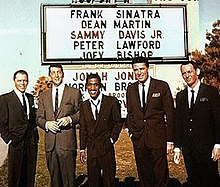Peter Lawford
His aunt, Jessie Bruce Lawford, another of his father's sisters, was the second wife of the Hon Hartley Williams, senior puisne judge of the Supreme Court of the colony of Victoria, Australia.
[7] Having studied Peter for so long, I decided he was quite unfitted for any career except art, so I cut Latin, Algebra, high mathematics and substituted dramatics instead.
"[7] Because of the widely varying national and religious backgrounds of his tutors, Lawford "attended various services in churches, cathedrals, synagogues and for some time was an usher in a Christian Science Sunday School...."[8] Around 1930, aged seven, he made his acting debut in the English film Poor Old Bill.
[14] Instead, Lawford pursued a career as an actor, a decision that resulted in one of his aunts refusing to leave him her considerable fortune, as she had originally planned.
He was screen tested and made his Hollywood debut in a minor part in the film Lord Jeff starring Freddie Bartholomew.
[16][17] Lawford and his family were living in Florida at the start of World War II, resulting in their assets, which were in Britain at the time, being frozen.
[19] His first decent role in a major film production was in A Yank at Eton (1942), starring Mickey Rooney, in which Lawford played a snobbish bully.
[22][23] At MGM he was a student in Above Suspicion (1943), a soldier in Pilot #5 (1943), a naval commander in The Sky's the Limit (1943) (with Fred Astaire), and an Australian in The Man from Down Under (1943).
He was a Frenchman in Paris After Dark (1943) and Flesh and Fantasy (1943), and was a student in MGM's Girl Crazy (1943) and The Adventures of Mark Twain (1944).
The studio signed him with a specific role in mind: The White Cliffs of Dover (1944), in which he played a young soldier during the Second World War.
[22] With actors such as Clark Gable and James Stewart away at war, Lawford was recognised as a new romantic lead on the MGM lot.
Lawford made My Brother Talks to Horses (1947) with Jackie Butch Jenkins, an early work of Fred Zinnemann which was a big flop.
He was Esther Williams' leading man in On an Island with You (1948) and supported Fred Astaire and Judy Garland in Easter Parade (1948), a huge hit, and Greer Garson and Walter Pidgeon in Julia Misbehaves (1948), also popular.
He was billed beneath Pidgeon and Ethel Barrymore in the anti-Communist The Red Danube (1949) and was one of Deborah Kerr's leading men in Please Believe Me (1950).
[30] Lawford's first film after Metro released him and several other players from their contracts was the comedy It Should Happen to You (1954), wherein he starred alongside Judy Holliday and Jack Lemmon.
Lawford had been first told of the basic story of the film by director Gilbert Kay, who heard the idea from a gas station attendant.
[33][34] Lawford played a British soldier in the acclaimed Israeli-set drama Exodus (1960) for Otto Preminger and had a cameo in Pepe (1960).
Lawford played a Senator in Advise & Consent (1962) for Preminger and was Lord Lovat in The Longest Day (1962), a war film with a star-studded cast.
[38] Lawford was Bette Davis's leading man in Dead Ringer (1964) and guest starred on The Alfred Hitchcock Hour, Profiles in Courage (as General Alexander William Doniphan), Bob Hope Presents the Chrysler Theatre and Run for Your Life.
He went on to produce the Patty Duke film Billie (1965) and had supporting roles in two Carroll Baker movies, playing her fiancé both times: Sylvia (1965) and Harlow (1965).
[41] He produced a film starring himself and Davis, Salt and Pepper (1968), and had support roles in Skidoo (1968) for Preminger, Buona Sera, Mrs. Campbell (1968), Hook, Line & Sinker (1969) with Jerry Lewis, and The April Fools (1969).
[43] Lawford was in The Phantom of Hollywood (1974), the pilot for Born Free, Rosebud (1975) for Preminger, Won Ton Ton: The Dog Who Saved Hollywood (1976), Hawaii Five-O, Fantasy Island, The Love Boat, Angels' Brigade (1979), Highcliffe Manor, Supertrain, Mysterious Island of Beautiful Women (1979), Gypsy Angels (1980), Body and Soul (1981), and episodes of The Jeffersons.
The break stemmed from a scheduled visit to Sinatra's home by Lawford's brother-in-law, President Kennedy, during a 1962 West Coast trip.
The change came at the last minute, after Sinatra had made extensive arrangements for the promised and eagerly awaited presidential visit, including the construction of a helipad, which he later destroyed in a fit of rage.
During his separation from Gould, Lawford met Patricia Seaton who became his fourth and final wife in July 1984, just months before his death.
[55] Lawford died at Cedars-Sinai Medical Center in Los Angeles on Christmas Eve 1984, aged 61, from cardiac arrest.




